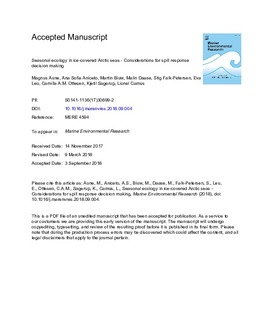Seasonal ecology in ice-covered Arctic seas - Considerations for spill response decision making
Aune, Magnus; Aniceto, Ana Sofia; Biuw, Martin; Daase, Malin; Falk-Petersen, Stig; Leu, Eva; Ottesen, Camilla; Sagerup, Kjetil; Camus, Lionel
Peer reviewed, Journal article
Published version
Permanent lenke
http://hdl.handle.net/11250/2581345Utgivelsesdato
2018Metadata
Vis full innførselSamlinger
- Articles [3009]
- Publikasjoner fra CRIStin [3056]
Sammendrag
Due to retreating sea ice and predictions of undiscovered oil and gas resources, increased activity in Arctic shelf sea areas associated with shipping and oil and gas exploration is expected. Such activities may accidentally lead to oil spills in partly ice-covered ocean areas, which raises issues related to oil spill response. Net Environmental Benefit Analysis (NEBA) is the process that the response community uses to identify which combination of response strategies minimises the impact to environment and people. The vulnerability of Valued Ecosystem Components (VEC's) to oil pollution depends on their sensitivity to oil and the likelihood that they will be exposed to oil. As such, NEBA requires a good ecological knowledge base on biodiversity, species' distributions in time and space, and timing of ecological events. Biological resources found at interfaces (e.g., air/water, ice/water or water/coastline) are in general vulnerable because that is where oil can accumulate. Here, we summarize recent information about the seasonal, physical and ecological processes in Arctic waters and evaluate the importance these processes when considering in oil spill response decision making through NEBA. In spring-time, many boreal species conduct a lateral migration northwards in response to sea ice retraction and increased production associated with the spring bloom. However, many Arctic species, including fish, seabirds and marine mammals, are present in upper water layers in the Arctic throughout the year, and recent research has demonstrated that bioactivity during the Arctic winter is higher than previously assumed. Information on the seasonal presence/absence of less resilient VEC's such as marine mammals and sea birds in combination with the presence/absence of sea ice seems to be especially crucial to consider in a NEBA. In addition, quantification of the potential impact of different, realistic spill sizes on the energy cascade following the spring bloom at the ice-edge would provide important information for assessing ecosystem effects.
